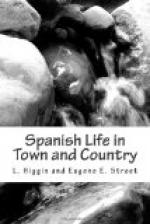The blankets and rugs of Palencia have been known to some few English people for many years, owing to their extreme lightness, great warmth, and literally unending wear; but it is only within the last very few years that they can be said to have had any market at all in England, and now they are called “Pyrenean” rather than Spanish goods. One of the suggestions of the little commercial circular already referred to is that Spaniards should open depots or special agencies all over England for the sale of their woollen goods, after the manner of the Jaeger Company.
The flocks of merino sheep to be seen on the wooded slopes of the Pyrenees, and all over Estremadura, following their shepherd after the manner with which Old Testament history makes us familiar, are said to be direct descendants of the old Arabian flocks, and certainly the appearance of one of these impassive-looking shepherds leading his flock to “green pastures, and beside the still waters,” takes one back in the world’s history in a way that few other things do. The flock know the voice of their shepherd, and follow him unquestioningly wheresoever he goes; there is no driving, no hurrying; and the same may be said of the pigs, which form such an important item in the social economy of a Spanish peasant’s home.
Staying once at Castellon de la Plana, in Valencia, my delight was to watch the pig-herd and his troop. Early in the morning, at a fixed hour, he issued from his house in one of the small alleys, staff in hand, and with a curious kind of horn or whistle. This he blew as he walked along, from time to time, without turning his head, in that strange trance of passivity which distinguishes the Valencian peasant. Out from dark corners, narrow passages, mud hovels on all sides, came tearing along little pigs, big pigs, dark, light, fat, thin pigs,—pigs of every description,—and joined the procession headed by this sombre-looking herdsman, with his long stick and his blue-and-white striped manta thrown over his shoulder. By the time he had reached the end of the village he had a large herd following him. Then the whole party slowly disappeared in the distance, under the groves of cork-trees or up the mountain paths. The evening performance was more amusing still. Just about sundown the stately herdsman again appeared with his motley following.




